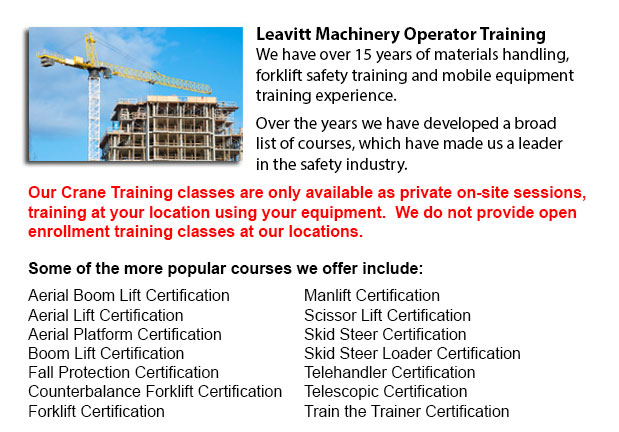
Kamloops Overhead Crane Safety Training - The overhead crane safety training program is intended to equip the operators with the right skills and knowledge in the areas of: crane safety precautions, materials handling, accident avoidance, and stock and equipment protection. Each of the trainees will get to learn about many kinds of overhead cranes, their capabilities and their uses in different settings. For operators who are trained and licensed, the shift in liability moves from the company to the operator. Thus, the course emphasizes individual operator tasks.
The operators in the overhead safety training course will be given instruction on the correct methods for carrying out checks: the more detailed in-depth inspection and the pre-shift inspection. These are vital every day routines that should be logged. Properly recorded pre-shift checks help to protect the company from liability in case of an accident. Pre-shift inspections also prevent accidents, damage and expensive repairs. Operators learn how to designate a particular person to carry out checks, how to report problems, and how to maintain the log book.
Checks must be performed regularly and documented properly. The following must checked while watching for usual problems: hooks for cracks, increases in the throat opening, hoist ropes for corrosion, degree of twist, loss of diameter, worn wires, bird caging and kinks, broken wires, chains for nicks and gouges, chemical and heat damage, twists, corrosion and cracks, distortion, excessive wear, pits, stretching, damage from extreme heat.
Operators learn proper rigging measures in this course. Rigging involves understanding the manufacturer's data plate, determining the material weight to be lifted, choosing the gear, and using safe practices to secure the load. The program include in detail the following: safe working loads, and the capacities of chains, ropes, slings, hooks and shackles.
It is vital to understand who can operate the cranes at your facility, the job's physical requirements, and operator qualifications needed for specialized job and permits. Safety is a top priority when using near pedestrian traffic.
The duties included in the safe crane use consists of checking for hydraulic leaks, undertaking visual inspections, checking the safety guards, testing the controls, examining the hoist rope and hook, braking mechanisms and limit switches. Correct reporting methods are important. These subject matters are all covered in depth in the program.
Correct moving and lifting methods with hoists and cranes are included in the program. Operators would become skilled in hand signals. Training involves how to raise the load, attach the load, set the load, unhook the slings and abort a lift.
Moving the load involves a number of steps: stopping and starting procedures, controlling and guiding the load, working with signals and observing working conditions. Operators must know how to proceed in case of a power failure. The program includes techniques for removing the slings and lowering the load, parking the crane, storage equipment, and securing an outdoor and indoor crane.
-
Kamloops Counterbalance Forklift Training
Kamloops Counterbalance Forklift Training - Counterbalance Forklift Training courses are always in high demand. The Counterbalance forklift is a forklift which is made with a weight which counters the balance, equally spreading the weight of the load... More -
Kamloops Manlift Certification
Kamloops Manlift Certification - The Manlifts and Elevated Platforms program offers training on the rules, regulations and proper application of safe operating measures and work practices included in daily activities for people who work making use of... More -
Kamloops Boom Lift Training
Kamloops Boom Lift Training - Elevated work platforms, likewise referred to as aerial platforms, allow workers to carry out tasks at heights that will otherwise be not reachable. There are various styles of lifts designed for different site applicati... More -
Operator Safety Certification | Re-Qualification Certification | In-House Instructor Certification in Kamloops
Forklifts are used in just about all industrial construction sites and in warehouse operations and in boat yards. The reach feature of a lift truck is a vital component used in several applications like for instance when a shelving system is being us... More -
Kamloops Manlift Safety Training
Kamloops Manlift Safety Training - It is essential for competent Manlift operators to be aware of the connected dangers that come with particular kinds of scissor lifts. They must be able to operate the scissor lift in a way that protects not only th... More -
Kamloops Crane Training Schools
Kamloops Crane Training Schools - We have designed several programs for Mobile Crane Operation at our Crane Training Schools. These programs are recommended for the experienced operator who requires certification or re-certification, and for inexperi... More -
Skid Steer Loader Certification in Kamloops
The engine powered skid-steer loader consists of a rigid and small frame, outfitted together with lift arms which could attach to a lot of industrial attachments and tools to perform several labor saving jobs. Typically, skid-steer loaders are four-w... More -
Kamloops Heavy Equipment License
Kamloops Heavy Equipment License - A heavy equipment license could be acquired by taking a certification and preparation course at a private training school or a vocational school. This license would qualify you to operate various types of heavy mach... More

Forklift Certification Kamloops
TOLL FREE: 1-888-254-6157
Kamloops, British Columbia
forkliftcertificationkamloops.com/
Email Us
About Us


